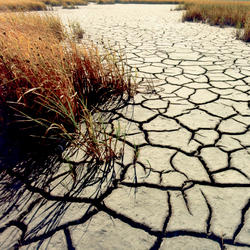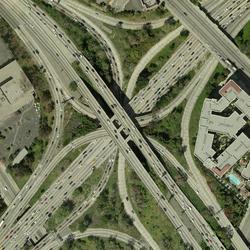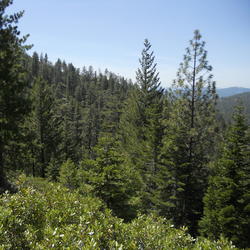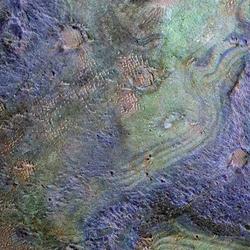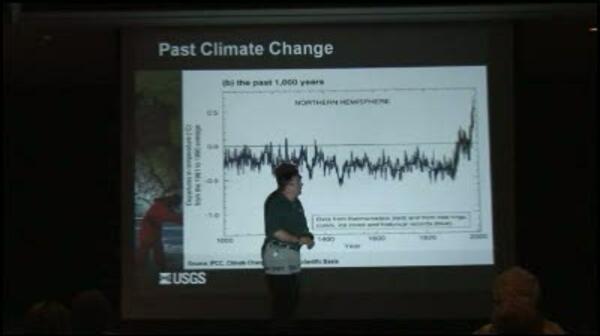More than 1,500 walruses resting on shore at Cape Grieg in southeastern Bristol Bay.
Does the USGS monitor global warming?
Not specifically. Our charge is to understand characteristics of the Earth, especially the Earth's surface, that affect our Nation's land, water, and biological resources. That includes quite a bit of environmental monitoring. Other agencies, especially NOAA and NASA, are specifically funded to monitor global temperature and atmospheric phenomena such as ozone concentrations.
The work through programs of our Land Resources mission (Land Change Science, National Land Imaging and Climate Adaptation Science Centers) focus on understanding the likely consequences of climate change, especially by studying how climate has changed in the past.
Related
Does an increase in the 100-year flood estimate originate from climate or land-use change? Does an increase in the 100-year flood estimate originate from climate or land-use change?
What are the long-term effects of climate change? What are the long-term effects of climate change?
What is the difference between weather and climate change? What is the difference between weather and climate change?
How can climate change affect natural disasters? How can climate change affect natural disasters?
How do changes in climate and land use relate to one another? How do changes in climate and land use relate to one another?
What are some of the signs of climate change? What are some of the signs of climate change?
How does carbon get into the atmosphere? How does carbon get into the atmosphere?
Has the USGS made any Biologic Carbon Sequestration assessments? Has the USGS made any Biologic Carbon Sequestration assessments?
Which area is the best for geologic carbon sequestration? Which area is the best for geologic carbon sequestration?
How much carbon dioxide can the United States store via geologic sequestration? How much carbon dioxide can the United States store via geologic sequestration?
What’s the difference between geologic and biologic carbon sequestration? What’s the difference between geologic and biologic carbon sequestration?
What is carbon sequestration? What is carbon sequestration?
More than 1,500 walruses resting on shore at Cape Grieg in southeastern Bristol Bay.
Data collected from long distance swims by Polar bears suggest that they do not stop to rest during their journey.
Data collected from long distance swims by Polar bears suggest that they do not stop to rest during their journey.
An adult female polar bear and her two cubs travel across the sea ice of the Arctic Ocean north of the Alaska coast.
An adult female polar bear and her two cubs travel across the sea ice of the Arctic Ocean north of the Alaska coast.
 What's the Big Idea? — Remote Sensing Understand Climate Change
What's the Big Idea? — Remote Sensing Understand Climate Change
Zhuoting Wu, research ecologist at the USGS Western Geographic Science Center, explains how the USGS uses remote sensing technology to help Tribal communities better understand the effects of climate change.
Zhuoting Wu, research ecologist at the USGS Western Geographic Science Center, explains how the USGS uses remote sensing technology to help Tribal communities better understand the effects of climate change.
 Climate Change Impacts on Aquatic Ecosystems in PNW
Climate Change Impacts on Aquatic Ecosystems in PNW
This webinar was held as a part of the Climate Change Science and Management Webinar Series, a partnership between the USGS National Climate Change and Wildlife Science Center and the FWS National Conservation Training Center.
This webinar was held as a part of the Climate Change Science and Management Webinar Series, a partnership between the USGS National Climate Change and Wildlife Science Center and the FWS National Conservation Training Center.
 Extreme Climate Events and Species Population Dynamics
Extreme Climate Events and Species Population Dynamics
This webinar was held as a part of the Climate Change Science and Management Webinar Series, a partnership between the USGS National Climate Change and Wildlife Science Center and the FWS National Conservation Training Center.
This webinar was held as a part of the Climate Change Science and Management Webinar Series, a partnership between the USGS National Climate Change and Wildlife Science Center and the FWS National Conservation Training Center.
This video was edited and compiled from raw footage recorded by a camera equipped radio collar that was put on a female polar bear in the Beaufort Sea during April 2014 by the US Geological Survey. This new type of camera technology was developed by videographer Adam Ravetch with the support of the World Wildlife Fund.
This video was edited and compiled from raw footage recorded by a camera equipped radio collar that was put on a female polar bear in the Beaufort Sea during April 2014 by the US Geological Survey. This new type of camera technology was developed by videographer Adam Ravetch with the support of the World Wildlife Fund.
 PubTalk 11/2012 — Understanding Climate-Wildlife Relationships
PubTalk 11/2012 — Understanding Climate-Wildlife Relationships
-- are American pikas harbingers of changing conditions?
by USGS Research Ecologist Erik Beever
-- are American pikas harbingers of changing conditions?
by USGS Research Ecologist Erik Beever
Adult female walrus on ice floe.
Adult female walrus on ice floe.
 Climate Connections: Questions from Glacier National Park, MT (Ep 4)
Climate Connections: Questions from Glacier National Park, MT (Ep 4)
America has questions about climate change, and the USGS has real answers. In this episode of Climate Connections, USGS scientists answer questions gathered from the beautiful Glacier National Park in Montana. Questions include:
America has questions about climate change, and the USGS has real answers. In this episode of Climate Connections, USGS scientists answer questions gathered from the beautiful Glacier National Park in Montana. Questions include:
America has questions about climate change, and the USGS has real answers. In this episode of Climate Connections, USGS scientists answer questions gathered from Puerto Rico. Questions include:
- Why has the rainy season been so long in Puerto Rico?
- How is global warming impacting the island of Puerto Rico?
America has questions about climate change, and the USGS has real answers. In this episode of Climate Connections, USGS scientists answer questions gathered from Puerto Rico. Questions include:
- Why has the rainy season been so long in Puerto Rico?
- How is global warming impacting the island of Puerto Rico?
 Climate Connections: Questions from North and South Carolina
Climate Connections: Questions from North and South Carolina
America has questions about climate change, and the USGS has real answers. In this episode of Climate Connections, USGS scientists answer questions gathered from North and South Carolina.
America has questions about climate change, and the USGS has real answers. In this episode of Climate Connections, USGS scientists answer questions gathered from North and South Carolina.
Climate change is an issue of increasing public concern because of its potential effects on land, water, and biological resources.
Climate change is an issue of increasing public concern because of its potential effects on land, water, and biological resources.
 USGS Public Lecture Series: Watching Nature's Clock: A Citizen-Scientist Effort to Track Seasonal Signs of Climate Change
USGS Public Lecture Series: Watching Nature's Clock: A Citizen-Scientist Effort to Track Seasonal Signs of Climate Change
USGS Public Lecture Series: Watching Nature's Clock: A Citizen-Scientist Effort to Track Seasonal Signs of Climate Change
linkA new USGS program, the USA National Phenology Network, is recruiting tens of thousands of volunteers to team up with scientists to help track the effects of climate on seasonal patterns of plant and animal behavior.
USGS Public Lecture Series: Watching Nature's Clock: A Citizen-Scientist Effort to Track Seasonal Signs of Climate Change
linkA new USGS program, the USA National Phenology Network, is recruiting tens of thousands of volunteers to team up with scientists to help track the effects of climate on seasonal patterns of plant and animal behavior.
Western Style
Michael Dettinger, USGS Research Hydrologist
Western Style
Michael Dettinger, USGS Research Hydrologist
USGS scientist Karyn Rode takes a blood sample from a polar bear to estimate the diets of wild bears.
USGS scientist Karyn Rode takes a blood sample from a polar bear to estimate the diets of wild bears.

Snowshoe hare experiencing camouflage mismatch in the spring at the Seeley Lake, MT, study site.
Snowshoe hare experiencing camouflage mismatch in the spring at the Seeley Lake, MT, study site.
Managing for tomorrow—A climate adaptation decision framework Managing for tomorrow—A climate adaptation decision framework
Climate change and future water availability in the United States Climate change and future water availability in the United States
U.S. Geological Survey climate science plan—Future research directions U.S. Geological Survey climate science plan—Future research directions
Characterizing urban heat islands across 50 major cities in the United States Characterizing urban heat islands across 50 major cities in the United States
Monitoring and assessing urban heat island variations and effects in the United States Monitoring and assessing urban heat island variations and effects in the United States
Simulation of water availability in the Southeastern United States for historical and potential future climate and land-cover conditions Simulation of water availability in the Southeastern United States for historical and potential future climate and land-cover conditions
Ecosystem vulnerability to climate change in the southeastern United States Ecosystem vulnerability to climate change in the southeastern United States
Climate Change Science Activities of the U.S. Geological Survey in New England Climate Change Science Activities of the U.S. Geological Survey in New England
Desert wetlands—Archives of a wetter past Desert wetlands—Archives of a wetter past
Changing arctic ecosystems—What is causing the rapid increase of snow geese in northern Alaska? Changing arctic ecosystems—What is causing the rapid increase of snow geese in northern Alaska?
USGS Arctic Science Strategy USGS Arctic Science Strategy
Climate change: evaluating your local and regional water resources Climate change: evaluating your local and regional water resources
Related
Does an increase in the 100-year flood estimate originate from climate or land-use change? Does an increase in the 100-year flood estimate originate from climate or land-use change?
What are the long-term effects of climate change? What are the long-term effects of climate change?
What is the difference between weather and climate change? What is the difference between weather and climate change?
How can climate change affect natural disasters? How can climate change affect natural disasters?
How do changes in climate and land use relate to one another? How do changes in climate and land use relate to one another?
What are some of the signs of climate change? What are some of the signs of climate change?
How does carbon get into the atmosphere? How does carbon get into the atmosphere?
Has the USGS made any Biologic Carbon Sequestration assessments? Has the USGS made any Biologic Carbon Sequestration assessments?
Which area is the best for geologic carbon sequestration? Which area is the best for geologic carbon sequestration?
How much carbon dioxide can the United States store via geologic sequestration? How much carbon dioxide can the United States store via geologic sequestration?
What’s the difference between geologic and biologic carbon sequestration? What’s the difference between geologic and biologic carbon sequestration?
What is carbon sequestration? What is carbon sequestration?
More than 1,500 walruses resting on shore at Cape Grieg in southeastern Bristol Bay.
More than 1,500 walruses resting on shore at Cape Grieg in southeastern Bristol Bay.
Data collected from long distance swims by Polar bears suggest that they do not stop to rest during their journey.
Data collected from long distance swims by Polar bears suggest that they do not stop to rest during their journey.
An adult female polar bear and her two cubs travel across the sea ice of the Arctic Ocean north of the Alaska coast.
An adult female polar bear and her two cubs travel across the sea ice of the Arctic Ocean north of the Alaska coast.
 What's the Big Idea? — Remote Sensing Understand Climate Change
What's the Big Idea? — Remote Sensing Understand Climate Change
Zhuoting Wu, research ecologist at the USGS Western Geographic Science Center, explains how the USGS uses remote sensing technology to help Tribal communities better understand the effects of climate change.
Zhuoting Wu, research ecologist at the USGS Western Geographic Science Center, explains how the USGS uses remote sensing technology to help Tribal communities better understand the effects of climate change.
 Climate Change Impacts on Aquatic Ecosystems in PNW
Climate Change Impacts on Aquatic Ecosystems in PNW
This webinar was held as a part of the Climate Change Science and Management Webinar Series, a partnership between the USGS National Climate Change and Wildlife Science Center and the FWS National Conservation Training Center.
This webinar was held as a part of the Climate Change Science and Management Webinar Series, a partnership between the USGS National Climate Change and Wildlife Science Center and the FWS National Conservation Training Center.
 Extreme Climate Events and Species Population Dynamics
Extreme Climate Events and Species Population Dynamics
This webinar was held as a part of the Climate Change Science and Management Webinar Series, a partnership between the USGS National Climate Change and Wildlife Science Center and the FWS National Conservation Training Center.
This webinar was held as a part of the Climate Change Science and Management Webinar Series, a partnership between the USGS National Climate Change and Wildlife Science Center and the FWS National Conservation Training Center.
This video was edited and compiled from raw footage recorded by a camera equipped radio collar that was put on a female polar bear in the Beaufort Sea during April 2014 by the US Geological Survey. This new type of camera technology was developed by videographer Adam Ravetch with the support of the World Wildlife Fund.
This video was edited and compiled from raw footage recorded by a camera equipped radio collar that was put on a female polar bear in the Beaufort Sea during April 2014 by the US Geological Survey. This new type of camera technology was developed by videographer Adam Ravetch with the support of the World Wildlife Fund.
 PubTalk 11/2012 — Understanding Climate-Wildlife Relationships
PubTalk 11/2012 — Understanding Climate-Wildlife Relationships
-- are American pikas harbingers of changing conditions?
by USGS Research Ecologist Erik Beever
-- are American pikas harbingers of changing conditions?
by USGS Research Ecologist Erik Beever
Adult female walrus on ice floe.
Adult female walrus on ice floe.
 Climate Connections: Questions from Glacier National Park, MT (Ep 4)
Climate Connections: Questions from Glacier National Park, MT (Ep 4)
America has questions about climate change, and the USGS has real answers. In this episode of Climate Connections, USGS scientists answer questions gathered from the beautiful Glacier National Park in Montana. Questions include:
America has questions about climate change, and the USGS has real answers. In this episode of Climate Connections, USGS scientists answer questions gathered from the beautiful Glacier National Park in Montana. Questions include:
America has questions about climate change, and the USGS has real answers. In this episode of Climate Connections, USGS scientists answer questions gathered from Puerto Rico. Questions include:
- Why has the rainy season been so long in Puerto Rico?
- How is global warming impacting the island of Puerto Rico?
America has questions about climate change, and the USGS has real answers. In this episode of Climate Connections, USGS scientists answer questions gathered from Puerto Rico. Questions include:
- Why has the rainy season been so long in Puerto Rico?
- How is global warming impacting the island of Puerto Rico?
 Climate Connections: Questions from North and South Carolina
Climate Connections: Questions from North and South Carolina
America has questions about climate change, and the USGS has real answers. In this episode of Climate Connections, USGS scientists answer questions gathered from North and South Carolina.
America has questions about climate change, and the USGS has real answers. In this episode of Climate Connections, USGS scientists answer questions gathered from North and South Carolina.
Climate change is an issue of increasing public concern because of its potential effects on land, water, and biological resources.
Climate change is an issue of increasing public concern because of its potential effects on land, water, and biological resources.
 USGS Public Lecture Series: Watching Nature's Clock: A Citizen-Scientist Effort to Track Seasonal Signs of Climate Change
USGS Public Lecture Series: Watching Nature's Clock: A Citizen-Scientist Effort to Track Seasonal Signs of Climate Change
USGS Public Lecture Series: Watching Nature's Clock: A Citizen-Scientist Effort to Track Seasonal Signs of Climate Change
linkA new USGS program, the USA National Phenology Network, is recruiting tens of thousands of volunteers to team up with scientists to help track the effects of climate on seasonal patterns of plant and animal behavior.
USGS Public Lecture Series: Watching Nature's Clock: A Citizen-Scientist Effort to Track Seasonal Signs of Climate Change
linkA new USGS program, the USA National Phenology Network, is recruiting tens of thousands of volunteers to team up with scientists to help track the effects of climate on seasonal patterns of plant and animal behavior.
Western Style
Michael Dettinger, USGS Research Hydrologist
Western Style
Michael Dettinger, USGS Research Hydrologist
USGS scientist Karyn Rode takes a blood sample from a polar bear to estimate the diets of wild bears.
USGS scientist Karyn Rode takes a blood sample from a polar bear to estimate the diets of wild bears.

Snowshoe hare experiencing camouflage mismatch in the spring at the Seeley Lake, MT, study site.
Snowshoe hare experiencing camouflage mismatch in the spring at the Seeley Lake, MT, study site.







